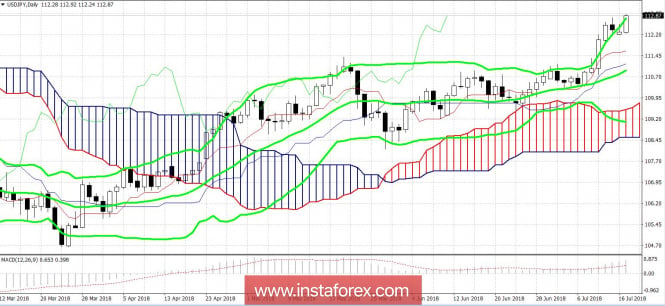The dollar-yen pair today resumed growth, updating the semi-annual price maximum. The Japanese currency is losing its positions again, resignedly following the greenback and the external fundamental background. There are no new arguments for the yen's growth. Moreover, the "dovish" position of the Bank of Japan renders background pressure on the national currency. Therefore, the southern pullback of the USD/JPY price can occur for two reasons: either because of the decline in the dollar index, or because of the aggravation of the trade war between the US and China (and / or the EU).
The trade conflict between the states and China is gradually losing the signs of a "classical" war in the conventional sense. Having exchanged the first economic blows, the parties began to behave asymmetrically. If Washington continued to prepare for the next "volley" in the form of new 10-percent duties on the six-thousand list of Chinese goods ($ 200 billion), then China took a somewhat passive position.
In its response, Beijing said that such actions by Americans harm not only the Chinese, but also the world economy, that is, indirectly, the States themselves. Then, representatives of the People's Republic of China filed another complaint to the WTO, publishing a short statement on this on the official website of the Ministry of Commerce. And that's all. This time, China did not "swing the sword" and threaten the opposing party with symmetrical actions or other measures of a reciprocal nature. This fact puzzled many market participants and among the traders there were rumors about the Chinese "capitulation".
Such a fundamental background allowed the bulls of the USD/JPY pair to finally gain a foothold above the key level of 110.00 and continue to grow. Then, the market began to discuss other information including the alleged attempt of China to create with the European Union a so-called "anti-American economic union" in order to jointly counteract the tariff policy of the White House. Information about such intentions appeared at the end of last week and allowed the yen to restore its position a little. The USD/JPY pair sank to the 112th figure's base.
However, this southern price retracement is even hard to call a correction, since at the beginning of this week, the growth of the USD/JPY pair again began to gain momentum. Most experts agreed that the "anti-American bloc", China-EU has no future, even if it will be created. Firstly, in this issue, it will be difficult to consolidate all the countries of the European Union. Secondly, Europe is not losing hope in someday agreeing with Donald Trump. The head of the European Commission Jean-Claude Juncker will visit Washington in late July, and he will hold talks with the head of the White House. If the findings of the profile committee on the impact of imports of European cars in the US will be in favor of Europe (announcement of the results of the investigation are expected next week), the results of Juncker's visit to the White House will be completed effectively. Therefore, Brussels is now not interested in escalating the situation and will not conclude any alliances with Washington against Beijing.
Thus, instead of developing a trade war, we see a slightly different scenario. The European Union has high hopes for Juncker's visit, and China has taken a somewhat passive and vague position in response to the White House's new intentions. It is too early to talk about Trump's "victory" or anyone's surrender. In our case, it is more important to know how the current situation is interpreted by the market. We see that the demand for protective assets has significantly decreased, including the yen. The dollar also reoriented its priorities somewhat, focusing on the prospects for the monetary policy of the Fed.
Here, it is worth recalling that this week (today and tomorrow), Jerome Powell will speak in the US Congress with a semi-annual report on monetary policy. At the moment, while he continues to speak, the information is only a fragment and incomplete. However, on the whole, it is already clear that Powell is still a supporter of a gradual rate hike, but at the same time he positively assesses the prospects for the American economy.
A combination of these factors pushes the USD/JPY pair up to new price highs. If tomorrow Jerome Powell continues his speech in the same vein as today, the probability of a fourfold increase in the rate this year will increase again and the US dollar will get an excuse for its strengthening.

The technical picture of the USD/JPY pair also speaks in favor of a move towards the north. The pair is above the Kumo cloud of the Ichimoku Kinko Hyo indicator and above all its lines. The bullish "Line Parade" signal indicates the potential for further price growth. In addition, the pair is located on the top line of the Bollinger Bands indicator. This also indicates the bullish sentiment of traders.
As the immediate goal of the upward movement, you can consider the mark 113.20 as the upper line of the indicator Bollinger Bands on the timeframe W1. Stop-loss can be located in the support level. This is the line Tenkan-sen on the daily chart (price 111.60).
The material has been provided by InstaForex Company - www.instaforex.com